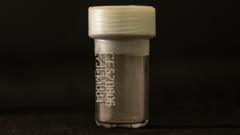The arrival of the first Moon dust in nearly half a century marks a notable milestone in lunar research. Loaned from China, these precious samples are now securely housed in Milton Keynes under the stewardship of UK researcher Professor Mahesh Anand, who hopes to unearth fundamental secrets of the Moon's genesis.
Moon Dust Rarer Than Gold: First Samples from China Arrive in the UK

Moon Dust Rarer Than Gold: First Samples from China Arrive in the UK
Historic Moon rock samples, collected in 2020, arrive on loan to a UK scientist for groundbreaking research.
Two weeks ago, tiny particles of Moon dust, considered rarer than gold, made their way into the UK from China, bringing excitement within the scientific community. These exceptional samples, which have been kept meticulously free from contamination, are currently stored in a high-security facility in Milton Keynes.
Professor Mahesh Anand, the only UK scientist granted this rare opportunity, remarked on the significance of the loan, stating, "Nobody in the world had access to China's samples, so this is a great honour and a huge privilege." His research aims to unravel the origins of the Moon, particularly the theory that it was created from debris following a massive collision between Earth and a Mars-sized planet around 4.5 billion years ago.
The precious Lunar materials were gathered during China's Chang'e 5 mission in December 2020, which marked the first successful collection of Moon samples since the Soviet missions of 1976. The mission captured public attention as China rapidly advanced in the space race, solidifying its position among the elite space-faring nations.
Last week, at a grand ceremony in Beijing, Professor Anand received the samples, which were transported back to the UK in his hand luggage to ensure their safety. Upon returning to his lab, the environment was prepared with the utmost care, including tacky mats and protective gear to prevent Earthly contamination.
Carefully secured in ziplock bags, the Moon dust's dark grey particles, amounting to only 60mg, may appear modest, but they hold the potential to reveal numerous cosmic mysteries. "Here, the small is mighty. Believe me, it is enough to keep us busy for years to come because we specialise in working on the micro," said Prof. Anand.
One of the technicians in charge of processing the samples, Kay Knight, expressed both excitement and nervousness. After 36 years of working with rocks, she acknowledged the high stakes of handling such a unique material. Others in the lab are equally equipped, including Sasha Verchovsky, who designed an innovative machine to analyze the Moon dust's gaseous components and James Malley, who plans to use lasers to explore its makeup.
The research team has a year to complete their analysis, during which they anticipate that their methods could lead to the destruction of some samples. However, this endeavor sets the stage for future collaborations, particularly as China plans to launch the Chang'e 6 mission, which aims to return samples from the Moon's unexplored far side.
Professor Anand hopes that these groundbreaking discoveries will foster ongoing cooperation between Chinese scientists and the rest of the world. "A lot of us built our careers working on samples returned by Apollo missions, and I think this is a fantastic tradition to follow. I hope that other countries will follow suit," he concluded.
As global interest in lunar exploration grows, the Moon dust project highlights the potential for shared knowledge and collective advancement in understanding Earth's celestial neighbor.


















